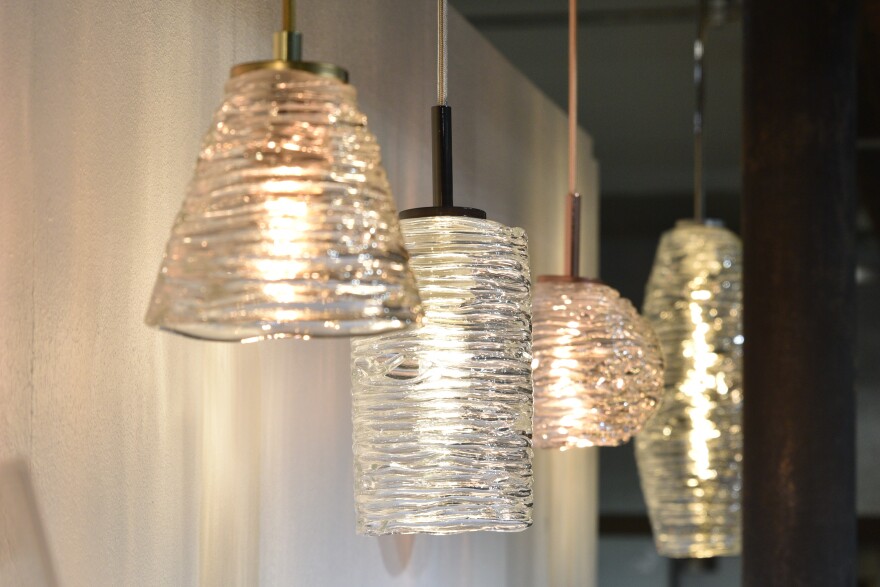
April Wagner is a glass blower. She has a line of art under her name, but she also makes beautiful and useful things under the Epiphany Glass name. I asked her to describe her work for someone who has never seen it.
“Freeform, colorful, contemporary, very sensuous. I really try to capture the look liquidity of the molten glass in the final piece so lots of curves, lots of really simple shapes that sort of build upon each other. That's what I'm passionate about,” Wagner said.
Making glass items dates back to 3500 B.C. About 1000 B.C., Egyptians started making simple vessels out of glass.
“It's amazing to me that you know ancient man could figure out a way to manipulate this material which is hot and you can't touch it with your hands, and just doesn't seem like something very inviting that you would do, and a lot of that hasn't changed at all. We're still using these same processes,” Wagner said.
Watching someone with the experience that Wagner has work with molten glass is fascinating. She uses gravity and centrifugal force and air from her lungs and tools to form what she wants.
“So, you bring to it what it is going to embody and it certainly has these physical properties that you can't change. So you learn how to work around them or stretch them a little bit," she said. "You learn how to kind of have this conversation with the material and sort of seduce it into this thing that you want it to do. But I am just continually fascinated by the fact that it goes from a liquid to a solid and it's either colorful or clear and it's really sparkling it seems like it's alive. It's a material that really speaks to me and how I understand my place in the world. Like I express the things I see and feel through this material.”
Wagner makes forming glass looks effortless, but it doesn’t take long to realize that effortlessness is an illusion. Watching a bright orange lump on the end of a punty rod turn into the shape she wants is amazing to see.
“Glass is, I would say, the hardest art form to learn how to do it. [It's] a year before you're making something that you want to make, and at that point it's a small cup. To learn how hot something is by reading temperature, I have to know the difference between different colors of orange to tell you what the glass is going to do or

when I'm turning the piece how quickly it's moving, then I can tell how hot it is or how gravity and centrifugal force are affecting that piece," Wagner said. "And learning that dialogue takes a very long time. I'm consistently and continually improving on those skills 'cause if there's something new I want to make. There's no manual out there on how to make it. I have to problem solve it start to finish."
Wagner says it can be heartbreaking when you make something and it fails at the very end.
"We just had this experience recently with some very large lights we were trying to make and got all the way done with the whole process, and went to knock it off the punty rod -- which is the end of the process before it goes into annealing oven. And they broke and they broke continuously. I still haven't figured out what the issue is. And I know it's something very simple that I need to change to correct it but I have to go through the whole process to fix that one little problem at the end of the piece," she explained.

Wagner said it took her a year-and-a-half to figure out how to make what she calls a tornado decanter. It’s a wine decanter that’s shaped to swirl the wine as it’s poured. It’s hard to imagine how it’s made.
Who buys hand-crafted glass items?
“Everyone," she said, laughing. "I have a wide variety because over the years -- I've been doing this for over 25 years now -- and my work keeps getting more and more expensive so I don't want to lose that customer who's always supported me at that hundred dollar under price point, which is part of the reason that we have the production lines that we can, you know, accommodate someone who wants something really nice and handmade but doesn't have a lot of extra income to purchase it,” Wagner added.
While she does sometimes work alone, designing a new piece or fashioning a proto-type, Wagner says there’s a social component to fashioning glass.
“Typically I make my work with at least one assistant, sometimes up to four or five assistants, and there has to be a synergy between all of us to, you know, make these split second decisions because the glass is really unforgiving. One wrong move and you're burnt or it's broke and there's no going back,” she said.

People are fascinated with the idea of working with glass. It’s alluring. Epiphany Glass even offers classes. But, Wagner says if somebody asked her if they should pursue the work:
“I would tell them not to do it," she laughed. "In all honesty I tell most young people who come to me and say they want to be an artist and I say no you don't. Right. And if I can talk them out of it that easily then no they shouldn't. It's really something that you have to be dedicated to. You have to make a lot of sacrifices. It's not a job. It's a life. Right?"
Support for arts and culture coverage comes from the Michigan Council for the Arts and Cultural Affairs.















